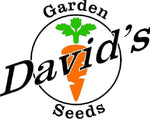Planting and Growing Corn

This page gives tips on planting and growing corn with many helpful tips and advice based on David's own experiences. This page also includes popcorn.
Read our Germination Tips before reading any further.
Read our soil testing page and soil temperature page.
When it comes to corn, there are many decisions to make. Read our page on Corn Types to find out what type of corn you need.
Dried corn types come in a multitude of colors. There are red, blue and orange cobs. There are cobs with all sorts of colors on them.
Sweet corn comes in two colors or a combination of two colors: white and yellow.
Corn is grown on a stalk, usually one ear per stalk. The stalk produces an ear of corn which is the husk, the cob, the seed, the silk and the tassel.
The corn seeds grow on the cob. The cob is where the actual corn grows. The cob is a cylindrical structure upon which kernel development occurs. Each corn seed starts off as an egg that needs to be pollinated.
To pollinate, the plant uses tassels and silks to accomplish this task. Each row of eggs has several hair like strands of silk running through them. These are fertilized by pollen from the tassels which are at the top of a stalk.
Timing is important. Depending on the type of corn you are growing, the harvest date will be determined by the drying of the silk. Generally, when the silk is dried, the corn is ready to harvest in about 18 to 24 days.
It is very important that sweet varieties are harvested during this time. If not, they will lose their sweetness. The best way to tell if corn is ready to harvest is to squeeze a kernel and if a milk-like substance comes out, then it is ready.
When planting corn, for the home gardener, it is best to plant only one type to avoid cross pollination. A sweet type will ruin a non-sweet type and vice versa if they cross pollinate.
The first time we grew corn, we did not get much yield. We planted our corn in a single row. Because of this, we had to hand-pollinate. It worked so we did get corn. What we have learned is that in order to pollinate correctly, corn needs to be planted in short, multiple rows. Otherwise the pollen does not get on all the silk like it needs to.
Water according to seed instructions.
The first time we grew corn we also had a problem with some kind of worm developing and eating the corn. We got about 2/3 of the cob and they got the rest. There are a multitude of organic insecticides and fungicides that can be used to keep your crop disease and insect free.
You may want to check with your county extension agent for help when choosing what will work best in your area.
Corn can also be treated which will allow for better germination in cooler soils. However, this treatment is non-organic so it will disqualify any organic seeds from the organic program.
There are many great YouTube videos for further help.
Once the season is done, shred the corn stalks and put in your compost pile or till in to the soil for the next crop you will plant in that area.







Leave a comment